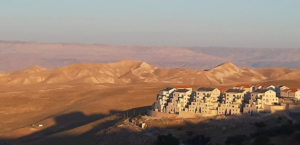
KFAR SABA, Israel — Ma’aleh Adumim is a small city in the Judean desert on the outskirts of Jerusalem with a population of more than 40,000 Israelis, including a large American contingent. It’s as close as a 10-minute drive for the many residents who work in or visit Israel’s largest city, Jerusalem. Ma’aleh Adumim is strategically located on the eastern side of Jerusalem on Route 1, a popular route to the lowest spot on earth, the Dead Sea. The town name Ma’aleh Adumim is taken from two mentions in the Bible of an area marking the boundaries between the Israelite tribes of Judah and Benjamin. Jews have a history there for at least 3,000 years, when King David united the 12 Israelite tribes and made Jerusalem his capital.
As early as 1968, just after the triumphant Six-Day War, retired general and then-politician Yigal Allon advanced a proposal to establish a settlement west of Jerusalem in land liberated during the Six-Day War. This plan was rejected as too controversial, but in 1975 Prime Minister Yitzhak Rabin of the ruling Labor Party sponsored the first community there (25 residential units to house 100 Israeli workers). Rabin soon added land for expansion; Ma’aleh Adumim is strategically located to defend Israel’s capital.
This action was in response to the recognition of the Palestine Liberation Organization (PLO) as the sole representative of the Palestinian Arabs. (Please recall that until the mid-1960s the Arabs living in the Palestine Mandate rejected the term, “Palestinian Arabs,” naming them “Arabs.” The Jewish residents in the Mandate called themselves Palestinian Jews and had institutions such as the Bank of Palestine, the Palestine Post, etc.) With encouragement from the left wing-controlled government and continuing under a right wing one, the town soon grew into a city, one of the largest in Area C, the zone which was placed under full Israeli control by the 1993 Oslo Accords. Fully 700,000 (10%) of Israel’s Jews live there today, including those in liberated Jerusalem.

Route 1, which abuts Ma’aleh Adumim, is in the E1 corridor, which Israel declared as a consequence of the UN giving Observer status to the “State of Palestine” in 2012. Israel has massive building plans there, so far unrealized except for a police station. There is a proposal to construct 3,412 homes in the corridor for a new neighborhood of Ma’aleh Adumim (there have been many construction proposals). This plan has been characterized by critics as a “doomsday” one. These adversaries, the UN and many EU member states, and a myriad of Israeli left wing and pro-Palestinian NGOs, contend that Israeli development on E1 would divide the West Bank into northern and southern regions and prevent the development of a contiguous Palestinian Arab state. The corollary to that is that much Arab building (already proceeding — illegally — under EU auspices) would divide Israeli territory into eastern and western blocs. Just now, Israel has demolished a building, for the second time, constructed in Area C by the EU. The EU’s enchantment with the Palestinian Authority, led by a terrorist who is in the 18th year of his four-year term, is incomprehensible.
Note: Jordan occupied much of Israel’s heartland between 1948 and 1967, when it controlled land which was part of the former British Mandate for Palestine. You may recall that the original Mandate territory was divided 78/22% by Britain in the early 1920s, giving the Arab Hashemite clan the major portion as “compensation” after losing its hegemony over Mecca and Medina, the two holiest Muslim sites, to the Saudi clan. Because the British were charged with allowing a National Home for the Jews to arise in the Mandate territory, the cleavage of 78% to the Arabs left only 22% for the Jews. It is this 22% that the Palestinian Arabs claim as their own state.
Following the British withdrawal from the Mandate territory in May 1948, and the immediate declaration of Israel’s independence, Israel defeated six Arab armies’ attempts to “throw the Jews into the sea.” However, the Jordanian forces thwarted Israeli efforts to regain all the territory designated for a national home by the Balfour Declaration of 1917. The later Mandate for Palestine included the tenets of the Balfour Declaration. which preceded and was included in the League of Nations British Mandate for Palestine.
In 1948 the United Nations passed a partition resolution to divide “Palestine” (the area of Judea renamed Palaestina in 132 CE by Rome in an attempt to minimize Jewish identification with the land of Israel) into Jewish and Arab — no mention of Palestinian — states. The Arabs rejected the plan outright and began attacks on Jewish cities and settlements. The Yishuv (pre-state Israel), under the leadership of David Ben-Gurion, accepted the partition plan and set to work to declare an independent state of Israel, which happened a half year later. Noting the small area allowed to the Jews, Ben-Gurion expected to enlarge the Jews’ territory despite the inevitable aggression of the nearby Arab countries.
From 1517 until 1917 the Turkish Ottoman Empire was the sovereign of the entire area of what it called Greater Syria, which included Palestine and much more. With its defeat in WW1, there was no sovereign in that area, just the British and French Mandates, which were temporary mandates. Therefore, the territories which Israel gained in the wars of 1948 and 1967 were not part of any “country.” In fact, the Arabs never had a capital in Palestine/Israel, while the Jews had established two monarchies in the land and had revered Jerusalem-Zion as its eternal capital for 3,000 years.
What’s the relevance of this history to Ma’aleh Adumim? While the city is practically within Jerusalem’s boundaries, it is outside of the now irrelevant (in my opinion) 1949 Armistice Lines, aka the Green Line. This has led to problems, including ramshackle Bedouin encampments in the E1 Corridor, and illegal European funded construction throughout Area C, which the Oslo Agreement designated for full Israeli control. (See picture below as one example of Bedouin communities.)
We visited Ma’aleh Adumim with friends who are trying to set up an American donors fund to help Ma’aleh Adumim. We met for lunch with the city’s popular longtime mayor, Benny Kashriel, who explained its economic shortfall, its long term prospects, and the situation with the E1 corridor and encroaching Bedouin shantytowns. Benny’s deputy, Racheli Vassal, whose title is Director of International Affairs, gave us a tour of the beautiful city with great housing, beautiful parks and landscaping, and space for new developments and buildings. There is a museum for famous artists, many cultural activities, including a national center for Ladino (Sephardic) culture, and a large development zone for new industry which already has many factories with Israeli and Arab workers.
The mayor explained that Ma’aleh Adumim’s finances are affected by its location outside of Israel’s internationally recognized “borders” (a misnomer for the abovementioned Armistice Lines), as are other similar communities like Alfe Menashe, our former home. Many international organizations and localized ones within Israel refuse to fund projects beyond the Armistice Lines. This, in the vain belief that Palestinian Arabs want peace, not the eradication of Israel. Building in the E1 corridor is critical to Israel’s security and must continue.
Ma’aleh Adumim have many of the amenities one finds in most Israeli cities but, with increasing immigration from Russia, Ukraine, and Ethiopia bringing new residents each year, as well as Israeli women’s high birth rates, there is a need for a fund — which is what the mayor proposed to us. In conversations with both Racheli and the mayor, one cannot help being carried away with their enthusiasm and devotion to the city and, of course, the State of Israel. It was this total commitment that inspired my friend Hank to organize a foundation to support the community.
Ma’aleh Adumim is one of the largest cities which Israel has developed beyond the Green Line. Its financial needs exceed its income because it’s ineligible for certain projects because of its location. Hank’s proposed foundation is being formed to aid and develop the city’s educational system by supplying hands-on vocational equipment and additional materials to the library, and to develop a social and cultural center for all its citizens, Jews and Arabs.